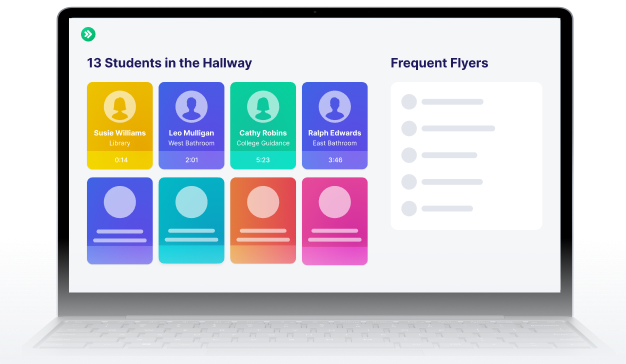In the News: Enhancing Safety in Schools Across Minnesota
Read the Story
SmartPass Co-Founders Listed on Forbes 30 Under 30
Read the Story

.avif)

Educators know how much school culture and student experiences throughout the day impact instruction and learning. Improving hallway behavior is an important goal when creating a conducive learning environment and positive school experience. Smooth transitions between classes, lowered hallway congestion, calmness and quiet that avoids disrupting instruction, and increased student safety all support students and teachers to make the most of class time.
On the other hand, when students are faced with loud and chaotic spaces, frequently miss class as part of rising absenteeism rates, deal with negative social interactions, or are worried about navigating from one place to another through hallway traffic, it impacts their ability to plug in when they get back to the classroom. For students with sensory processing difficulties or challenges navigating a congested hallway, it quickly becomes an accessibility issue. Preventing disruptions in the hallway and encouraging positive behavior helps everyone!
While creating and enforcing clear hallway behavior policies and supporting student responsibility has always been a necessary focus for school principals and teachers, the need has increased in recent years. According to the National Center for Education Statistics (NCES), 84% of schools in their 2022 survey reported that the Covid pandemic had negatively impacted student behavioral development. Plus, 48% of schools surveyed reported that “rowdiness outside of the classroom” had increased.
Schools have a wide range of needs and gaps in and out of the classroom to address since Covid, which is stretching time, energy, and resources thinner than ever. This makes finding effective strategies for hallway behavior essential.
Schools tend to have a pretty standard list when they define goals for positive hallway behavior expectations for students:
All of these provide a solid foundation for students and give them a sense of shared responsibility. As positive behavior trends or repeated negative behavior issues pop up, schools can adapt their expectations and look for strategies to fit the strengths and needs of their students.
Students and staff all benefit when everyone’s on board with a plan for improving hallway behavior. A school-wide focus on meaningful connections with students, personal responsibility, and cooperative school culture building can be a big help in making that plan. When students are part of the discussion on how they want their community to look, feel, and sound, they build collective efficacy. It increases their buy-in, helps them feel more connected to fellow students, and allows for positive peer influence on hallway behavior.
The first step to creating a respectful hallway environment is to start with clear expectations. Work as a staff and school community to outline the behaviors that would help everyone thrive and give students time and support in learning them. Communicate the final policies clearly and give staff the tools and structure they need to enforce them when needed. As students go about their days, consistent enforcement helps build understanding and integrate the expected hallway behaviors into the school culture. It’s important to find opportunities to use positive reinforcement when students exhibit positive hallway behavior choices to showcase examples and encourage continued progress.
Teachers can help with promoting and modeling good hallway behavior and monitoring hallway behavior effectively. The role teachers have in supporting a community approach to hallway behavior expectations and leading calm and welcoming transitions in and out of the classroom is invaluable. They are students' closest and most frequent points of contact and can spot trends quickly.
Hallway behavior management can’t be handled by the teachers alone, though. They have classrooms to manage, materials to plan and prepare, students to interact with, and a million other things throughout the day. If teachers were to monitor hallways constantly, it would be inefficient and other parts of students’ experience and learning would suffer.
On top of that, the juggle of classroom, curriculum, and keeping a constant eye on hallway traffic only adds to teacher burnout. Teachers are struggling and reported experiencing stress in the workplace at twice the rate of other working adults in the USA in a recent survey. In the same survey, 59% indicated they were experiencing burnout and 30% shared that increased workload from staff shortages and managing student behavior were key sources of that reported stress.
Student safety is a key goal when setting hallway behavior expectations. Students may be wandering hallways when they’re supposed to be in class or other meetings. Students meeting up in hallways can lead to issues like friend groups that are loud and disruptive, vandalism, problems like vaping, or negative social interactions or bullying. Protocols and procedures to monitor these kinds of issues and set up ways for whole school teams to enforce consistently are helpful.
Look for ways to prevent student groups that have a history of gathering or meeting unexpectedly. Make it easy for students to know what’s expected, how they can help build a school culture that prevents issues, and what they can do if something’s wrong. Give everyone the tools and information they need to identify which situations are likely to become unsafe and strategies to use in the moment.
On top of immediate safety concerns, school hallway behavior management needs to account for emergency response plans. Teachers and staff need to be able to identify who should be where. Students should be able to get somewhere safe easily and calmly if needed. When structure and tools are in place for those things are in place and it’s easy for everyone to coordinate, it keeps students safer.
Disruptions in the hallway can happen in large crowds or when most students are in class. The type of disruption can vary, but they often involve running, shouting, and loitering. When students are delaying a return to class or meeting, they may be interrupting the learning environment of classes they pass with their disruption. If it’s during transitions with more students in the hallway, it can become loud, stressful, and make it more difficult for the other students to move through their school day. It can also easily lead to injuries or other dangers, especially when combined with hallway traffic and congestion.
There are a host of strategies like managing the number of students leaving class at a particular time or going to a certain area, encouraging efficient student breaks that serve their needs without adding unnecessary time out or increased noise, and planning student movements to be staggered and well-coordinated during special events can prevent many of the potential disruptions and congestion issues.
As students move through different ages, they’re able to take on new responsibilities in maintaining respectful hallway behavior. It’s important to set expectations and supports with their developmental stage and current skills in mind, while looking for ways to encourage them to grow into more levels of accountability and self-guidance. The repeated communication of expectations will play a big role in this. Providing tools and skills for self-regulation can help. Encourage students to find ways to positively reinforce each others’ efforts.
Through all of this, it’s important teachers and principals find where students are taking strong responsibility and showing positive hallway behavior patterns and support it with additional resources and trust, while also catching areas where students may be struggling and need more oversight or guidance.
Hallway behavior improvement programs can improve learning experiences, increase student and staff well-being and safety, and help develop students’ self-regulation and accountability skills. To track and increase the impact of the programs, schools can employ a variety of supervision strategies to monitor and assess hallway behavior. Each school community will have a unique combination of needs and resources, so the key is finding the best mix available when getting started and making adjustments over time.
Some of the simplest measures are found in intentional communication of expectations, positive reinforcement options, and potential consequences. Make them visible, talk about them, and encourage students to help revisit and reinvigorate them as the school year goes by. Give students safe ways to share concerns or experiences. Give teachers and staff plenty of time and support to be engaged with students during transition times without losing the time they need to be prepared and rested for instruction. Other staff and administrators should be out in the hallways at key times, as well.
Coordinating student needs with instruction time is important, but when it’s happening in the moment, it can be rushed. While manually approving and tracking student movement through halls during class time is possible, the right technology can make that management, recording, and assessing much easier and more effective. In fact, technology can support and simplify the communication, management, and engagement involved with encouraging positive hallway behavior each step of the way.
Efficient hallway behavior monitoring can go a long way toward improving school culture and helping school leadership make clear and positive decisions over time. It can give chances for community progress toward common goals and positive reinforcement. In cases where negative interactions or behaviors are still occurring, it’s also important for student safety. This is especially true in cases like bullying.
Preventing bullying is a school-wide effort. Clear communication about how to identify bullying, how to address it in the moment, and how to report it all help students and community members play a part in decreasing bullying. Teacher presence and interventions, staff coordination, and school policy can raise awareness, teach students how to interact in healthy ways, and how to advocate for themselves.
Hallway behavior management is a central part of bullying prevention, as well. Students have the right to feel safe in their own hallways, yet students in an NCES report shared that 42% of bullying happened in the hallway and stairway areas. Cutting down on time students spend loitering in the hallway, preventing student interactions that are likely to lead to bullying, and providing a structure for monitoring, identifying, and addressing bullying are all ways that a positive hallway behavior program can prevent and address bullying.
The experiences students and teachers have in the hallway can set up a great transition into learning activities or it can add to stress and impact school culture. It’s important to begin with a solid foundation of expectations and safety protocols that will lead to good outcomes for everyone and to identify the strategies to support them. Clear communication and thoughtful inclusion of teachers and students in the process gives everyone a role to play and allows for more growth and positive reinforcement without letting potential issues slip by unnoticed.
As big an order as that seems to be, it is possible to set up the structures and strategies to make it easier and less stressful! Schools just need to find the right tool kit for their crew. SmartPass is a comprehensive solution for hallway management that can support schools in their journey to improving hallway behavior and creating a safer, more efficient, and positive school environment.
Tools like encounter prevention can help prevent conflicts and No Contract Agreement violations. Pass permissions and features can enable student autonomy, lower classroom interruptions, and keep up with student meetings and needs. Monitoring and clear records help guide decisions, highlight successes, pinpoint possible issues, lower teacher workload, and make coordinating easier. Plus, it’s a system that can be set up and adopted quickly and simply. If your school is looking for support with better hallway behavior management and overall school safety, consider integrating SmartPass!


.jpg)
